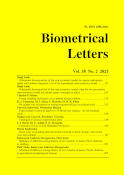
Biometrical Letters Vol. 58(2), 2021, pp. 209-219


In this paper, we investigate the effect of seeding density on several morphological features such as plant height, height of the production ears, ear length, ear diameter, leaf area, and LAI (leaf area index). Inference is based on a series of three-year two-factor experiments with two hybrid maize varieties - SY Cooky and Drim "stay-green" type - and 5 sowing densities: 6, 7, 8, 9 and 10 plants per m2. The "stay-green" maize variety had production cobs significantly higher on the plant, and had a thicker cob and a larger leaf assimilation area than the conventional variety. Increasing maize sowing density from 6 to 10 plants m-2 resulted in a linear decrease in cob length and diameter, while it increased the LAI. Significantly higher chlorophyll content, expressed in SPAD units, was found in the "stay-green" hybrid at the BBCH 67 stage in a wet (2012) and drier year (2014), compared with the traditional variety. This may indicate that such a variety is more tolerant to stress conditions.

chlorophyll, morphological features, sowing density, split-plot designs, Tukey's test, Zea mays L.

